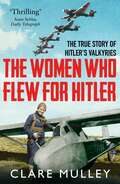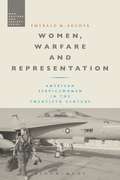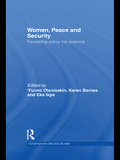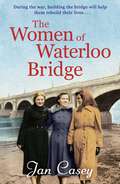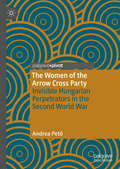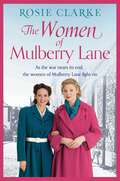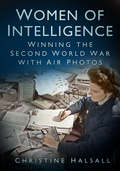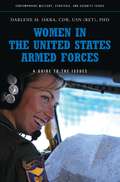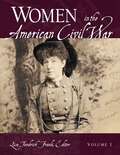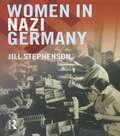- Table View
- List View
The Wonder of War on Land (The World At War)
by Francis Rolt-WheelerFrancis Rolt-Wheeler (1876 - 1960) was born Francis William Wheeler in Forest Hills, England. He lived with his family, in England, until some time before 1901. He crossed the Atlantic where he became a naturalised US citizen in 1903, working as a journalist. Starting around 1906, Wheeler made a name for himself -- as Francis Rolt-Wheeler -- as a writer of books, mostly for boys, like The Boy with the United States Survey and The Boy with the US Trappers. He also published a 10 volume Science-History of the Universe, books for children with topics ranging from Aztecs to dinosaurs to Thomas Alva Edison, a series of books on aspects of the first world war, and some poetry and drama. Francis Rolt-Wheeler remained in the US until the late 1920, and his reputation as a writer of popular boy's material continued to wax through the 1920s. He was traveling globally quite a bit during this period and left the US for the Middle East, where he began his second career as an occultist. The Rolt-Wheeler handle was used by both Francis and his sister Ethel, a poet, writer, reincarnationist and Fellow of the Theosophical Society.
The Women's War of 1929: Gender and Violence in Colonial Nigeria
by Marc Matera Misty L. Bastian S. Kingsley Kent Susan Kingsley KentIn 1929, tens of thousands of south eastern Nigerian women rose up against British authority in what is known as the Women's War. This book brings togther, for the first time, the multiple perspectives of the war's colonized and colonial participants and examines its various actions within a single, gendered analytical frame.
Women’s War: Fighting and Surviving the American Civil War
by Stephanie McCurryThe Civil War is remembered as a war of brother against brother, with women standing innocently on the sidelines. But battlefield realities soon challenged this simplistic understanding of women’s place in war. Stephanie McCurry shows that women were indispensable to the unfolding of the Civil War, as they have been—and continue to be—in all wars.
The Women's Land Army in First World War Britain
by B. WhiteBetween 1917 and 1919 women enlisted in the Women's Land Army, a national organisation with the task of increasing domestic food production. Behind the scenes organisers laboured to not only recruit an army of women workers, but to also dispel public fears that Britain's Land Girls would be defeminized and devalued by their wartime experiences.
The Women Who Lived For Danger: Behind Enemy Lines During Wwii
by Marcus BinneyIn World War II, 37 women were dropped in occupied France to work as Special Operations Executive agents and 'set Europe ablaze'. 13 never returned. They were executed in Hitler's concentration camps. This is the fascinating story of eight of those female agents, all striking beauties (despite the need to be inconspicuous), all from civilian life, who were warned of the likelihood of arrest, torture and a brutal death before they volunteered. None demurred. These young women were given months of arduous fitness, gun, explosives, endurance and code training before parachuting into occupied territory. But Women Who Lived for Danger also contains eight very personal tales. Why did these women volunteer? Where did they come from? Marcus Binney tells of a life of Resistance work and uncover operations, clandestine activities and even armed combat, and a constant fear of discovery. But above this book tells of extreme bravery and devotion to duty.
The Women Who Flew for Hitler: The True Story of Hitler's Valkyries
by Clare MulleyHanna Reitsch and Melitta von Stauffenberg were talented, courageous and strikingly attractive women who fought convention to make their names in the male-dominated field of flight in 1930s Germany. With the war, both became pioneering test pilots and both were awarded the Iron Cross for service to the Third Reich. But they could not have been more different and neither woman had a good word to say for the other.Hanna was middle-class, vivacious and distinctly Aryan, while the darker, more self-effacing Melitta, came from an aristocratic Prussian family. Both were driven by deeply held convictions about honour and patriotism but ultimately while Hanna tried to save Hitler's life, begging him to let her fly him to safety in April 1945, Melitta covertly supported the most famous attempt to assassinate the Führer. Their interwoven lives provide a vivid insight into Nazi Germany and its attitudes to women, class and race.Acclaimed biographer Clare Mulley gets under the skin of these two distinctive and unconventional women, giving a full - and as yet largely unknown - account of their contrasting yet strangely parallel lives, against a changing backdrop of the 1936 Olympics, the Eastern Front, the Berlin Air Club, and Hitler's bunker. Told with brio and great narrative flair, The Women Who Flew for Hitler is an extraordinary true story, with all the excitement and colour of the best fiction.
Women, Warfare and Representation: American Servicewomen in the Twentieth Century (War, Culture and Society)
by Emerald M. ArcherWomen, Warfare and Representation considers the various ways the American servicewoman has been represented throughout the 20th century and how those representations impact the roles she is permitted to inhabit. While women have a relatively short history in the American military, the last century shows an evolution of women's direct participation in war despite the need to overcome societal sex-role expectations. The primary focus is on the American case, but Emerald Archer also introduces a comparative element, showing how women's integration in the military differs in other countries, including Great Britain, Canada and Israel. Adopting an interdisciplinary approach, the book draws on military history, theory and social psychology to offer a more complete and integrated history of women in the military and their representation in society.
Women, Warfare and Representation: American Servicewomen in the Twentieth Century (War, Culture and Society)
by Emerald M. ArcherWomen, Warfare and Representation considers the various ways the American servicewoman has been represented throughout the 20th century and how those representations impact the roles she is permitted to inhabit. While women have a relatively short history in the American military, the last century shows an evolution of women's direct participation in war despite the need to overcome societal sex-role expectations. The primary focus is on the American case, but Emerald Archer also introduces a comparative element, showing how women's integration in the military differs in other countries, including Great Britain, Canada and Israel. Adopting an interdisciplinary approach, the book draws on military history, theory and social psychology to offer a more complete and integrated history of women in the military and their representation in society.
Women, Sexuality and War
by P. GoodmanThis book examines women's experiences in Britain during the Second World War, drawing on women's own memories and archival sources. It explores the myths and silences surrounding women's contribution to the war effort. Part of the text is devoted to women's experience of paid employment and how their sexuality became a contentious workplace issue. This theme is continued in the accounting for the sexuality of women on other spaces and places and how women re-negotiated their femininity, and thus their own 'war experiences'.
Women, Peace and Security: Translating Policy into Practice (Contemporary Security Studies)
by ’Funmi OlonisakinThis book provides a critical assessment of the impact of UN Resolution 1325 by examining the effect of peacebuilding missions on increasing gender equality within conflict-affected countries. UN Resolution 1325 was adopted in October 2000, and was the first time that the security concerns of women in situations of armed conflict and their role in peacebuilding was placed on the agenda of the UN Security Council. It was an important step forward in terms of bringing women’s rights and gender equality to bear in the UN’s peace and security agenda. More than a decade after the adoption of this Resolution, its practical reality is yet to be substantially felt on the ground in the very societies and regions where women remain disproportionately affected by armed conflict and grossly under-represented in peace processes. This realization, in part, led to the adoption in 2008 and 2009 of three other Security Council Resolutions, on sexual violence in conflict, violence against women, and for the development of indicators to measure progress in addressing women, peace and security issues. The book draws together the findings from eight countries and four regional contexts to provide guidance on how the impact of Resolution 1325 can be measured, and how peacekeeping operations could improve their capacity to effectively engender security. This book will be of much interest to students of peacebuilding, gender studies, the United Nations, international security and IR in general.
Women, Peace and Security: Translating Policy into Practice (Contemporary Security Studies)
by Funmi Olonisakin Karen Barnes Eka IkpeThis book provides a critical assessment of the impact of UN Resolution 1325 by examining the effect of peacebuilding missions on increasing gender equality within conflict-affected countries. UN Resolution 1325 was adopted in October 2000, and was the first time that the security concerns of women in situations of armed conflict and their role in peacebuilding was placed on the agenda of the UN Security Council. It was an important step forward in terms of bringing women’s rights and gender equality to bear in the UN’s peace and security agenda. More than a decade after the adoption of this Resolution, its practical reality is yet to be substantially felt on the ground in the very societies and regions where women remain disproportionately affected by armed conflict and grossly under-represented in peace processes. This realization, in part, led to the adoption in 2008 and 2009 of three other Security Council Resolutions, on sexual violence in conflict, violence against women, and for the development of indicators to measure progress in addressing women, peace and security issues. The book draws together the findings from eight countries and four regional contexts to provide guidance on how the impact of Resolution 1325 can be measured, and how peacekeeping operations could improve their capacity to effectively engender security. This book will be of much interest to students of peacebuilding, gender studies, the United Nations, international security and IR in general.
The Women of Waterloo Bridge: the heart-wrenching WW2 saga of 2020
by Jan CaseyLondon, 1940. After her fiancé breaks off their engagement, Evelyn decides to do her part for the war effort by signing up for construction work on Waterloo Bridge. Enjoying the physical work and her newfound purpose, she begins to realise that there could be so much more to her life than anything she'd ever dared to dream of. Grieving after her little boy dies in an air raid, Gwen is completely lost when her husband sends their younger children to the countryside for safety. Enlisting as a construction worker, she is partnered with cheerful Evelyn. Despite Gwen's initial reticence, the two women strike up a heartwarming friendship – but will it be enough to save Gwen from her sorrow? Musical prodigy Joan's life has always been dictated by her controlling mother. When an affair nearly ends in scandal, Joan finally takes her life into her own hands. Determined never to touch a violin again, she soon finds work at Waterloo Bridge. Yet there are other troubles for her to overcome... For these three women, only one thing is certain: the Second World War will change their lives forever. A heart-wrenching new WW2 saga for fans of Jenny Holmes and Soraya M. Lane.
The Women of the Arrow Cross Party: Invisible Hungarian Perpetrators in the Second World War
by Andrea PetőThis book analyses the actions, background, connections and the eventual trials of Hungarian female perpetrators in the Second World War through the concept of invisibility. It examines why and how far-right women in general and among them several Second World War perpetrators were made invisible by their fellow Arrow Cross Party members in the 1930s and during the war (1939-1945), and later by the Hungarian people’s tribunals responsible for the purge of those guilty of war crimes (1945-1949). It argues that because of their ‘invisibilization’ the legacy of these women could remain alive throughout the years of state socialism and that, furthermore, this legacy has actively contributed to the recent insurgence of far-right politics in Hungary. This book therefore analyses how the invisibility of Second World War perpetrators is connected to twenty-first century memory politics and the present-day resurgence of far-right movements.
Women of Steel: The Feisty Factory Sisters Who Helped Win the War
by Michelle RawlinsTrue stories of love and loss during WWII, from the tough Northern women who kept the foundry fires burning.When war broke out, the young women of Sheffield had their carefree lives turned upside down. With their sweethearts being sent away to fight, they had no choice but to step into the men's shoes and become the backbone of the city's steel industry. Through hard toil and companionship, they vowed to keep the foundry fires burning and ensured that soldiers had the weapons, planes and ships needed to secure victory over Hitler.When the men returned from the front in 1945, many of these women tragically found themselves discarded 'like yesterday's fish and chip wrappers'. But decades later, a grassroots campaign spearheaded by the elderly Women of Steel finally brought their remarkable story to light.Women of Steel is the last chance to hear these unsung heroines' voices, as they share first-hand how a group of plucky young women rallied together to win the war for Britain.
The Women of Mulberry Lane (The Mulberry Lane Series #5)
by Rosie ClarkeLove and heartbreak, birth and death, joy amid hardship, are all here in the gripping fifth novel about the people of Mulberry Lane during World War Two. The war is nearly over – or is it? The women of Mulberry Lane anxiously wait for news. Peggy doesn't know if she'll ever again see Able, the American father of her twins, while a very odd letter from estranged husband, Laurie, threatens to set the cat among the pigeons. Rose can't stop loving Jimmy, while Tom can't stop loving her. Will Gordon ever again be the man he once was? Can he be a proper husband to Maureen, and if he can't, what will become of their marriage? The men, women and children of Mulberry Lane fight on with indomitable spirit, as the endgame of the Second World War enters its most deadly phase.
Women of Intelligence: Winning the Second World War with Air Photos (History Press Ser.)
by Christine HalsallIn World War Two an ornate Victorian mansion, overlooking the River Thames at Medmenham, in Buckinghamshire, was the Headquarters of the Allied Central Interpretation Unit. It was here that the air photography, obtained by reconnaissance aircraft flying over the whole of enemy and occupied Europe, was analysed by Photographic Interpreters: the Intelligence produced from their reports influenced virtually every Allied operation planned and carried out during the war. An analytical mind, curiosity, the ability to search for clues and recognise the unusual were essential qualities for the Interpreters and found in men and women from scientific and artistic backgrounds. They included a daughter of Winston Churchill. Women made up half of the work force, as every aspect of enemy activity was watched and analysed. Now the women of Medmenham, the ‘Women of Intelligence’, tell the story of their wartime life and work – in their own words.
Women in the War
by Lucy Fisher‘An important contribution to our recent history’ ANDREW MARR ‘Absorbing and important’ JOAN BAKEWELL ‘One of my favourite reads of 2021’ GARETH RUSSELL
Women in the United States Armed Forces: A Guide to the Issues (Contemporary Military, Strategic, and Security Issues)
by Darlene M. IskraThis handbook provides the reader with an historical and contemporary overview of the service by women in all branches of the U.S. military, tracing the causes and effects of evolving policies, issues, structural barriers, and cultural challenges on the record and in the future of the accomplishments by women warriors.Women in the United States Armed Forces: A Guide to the Issues covers over a century of accomplishments of military women, from the Civil War to the current wars in the Middle East. Readers will learn, for example, that during World War II, 565 women in the Women's Army Corps stationed in the Pacific theater received combat decorations, proving that women had the courage, strength, and stamina to perform in a combat environment. They will also learn that, perhaps surprisingly, it wasn't until the mid- to late 1970s that women had their first opportunities to serve at sea and as aviators (crew as well as pilots), albeit on noncombatant ships and aircraft. The book's final four chapters discuss the issues that continue to plague women in the military, including sexual harassment, noting that women's performance in America's two-front wars in Iraq and Afghanistan have made a positive difference in attitudes. The handbook closes with an epilogue that is at once a summary of the issues and a call for action.
Women in the United States Armed Forces: A Guide to the Issues (Contemporary Military, Strategic, and Security Issues)
by Darlene M. IskraThis handbook provides the reader with an historical and contemporary overview of the service by women in all branches of the U.S. military, tracing the causes and effects of evolving policies, issues, structural barriers, and cultural challenges on the record and in the future of the accomplishments by women warriors.Women in the United States Armed Forces: A Guide to the Issues covers over a century of accomplishments of military women, from the Civil War to the current wars in the Middle East. Readers will learn, for example, that during World War II, 565 women in the Women's Army Corps stationed in the Pacific theater received combat decorations, proving that women had the courage, strength, and stamina to perform in a combat environment. They will also learn that, perhaps surprisingly, it wasn't until the mid- to late 1970s that women had their first opportunities to serve at sea and as aviators (crew as well as pilots), albeit on noncombatant ships and aircraft. The book's final four chapters discuss the issues that continue to plague women in the military, including sexual harassment, noting that women's performance in America's two-front wars in Iraq and Afghanistan have made a positive difference in attitudes. The handbook closes with an epilogue that is at once a summary of the issues and a call for action.
Women in the Military Orders of the Crusades (The New Middle Ages)
by M. BomThis study of the female members of the Order or Hospital of Saint John of Jerusalem in the High Middle Ages analyses their presence in the context of female monasticism and compares their position to the position of women in other religious military orders. Introducing questions of gender into the history of the military orders.
Women in the Military
by Rita James SimonThe role, status, and treatment of women is one of the major issues confronting the military today. This volume provides a range of perspectives on the magnitude of concerns, the sources of problems, how issues might best be addressed, and the future for women in the armed services. It is based on a special issue of the journal Gender Issues, supplemented with additional contributions from leading scholars.Historical and theoretical perspectives are provided by Lorry M. Fenner and Jean Bethke Elshtain. Fenner focuses on the role of women in the military since 1940, and argues for broader inclusion of women as well as other groups that have previously been restricted from full participation. Elshtain analyzes the extraordinary ability of war to draw both women and men into civic life, and observes how it calls forth and establishes a sense of particular identity for both men and women.Critical views are provided by other scholars. Laura L. Miller examines the feminist movement's insistence on full participation in combat units. Former Army chaplain Marie deYoung provides qualitative and quantitative data on military readiness and unit cohesion in mixed gender units. Leading military scholars (Mady W. Segal, David R. Segal, Jerald G. Bachman, Peter Freedman-Doan, and Patrick M. O'Malley) review national surveys comparing male and female high school seniors' responses to surveys conducted on questions about their propensity to enlist. Male-female differences are also addressed by Judith Hicks Steihm, who looks at the opinions each group has about the capabilities and performance of women. She finds differences by rank on questions as to how hard female soldiers work as compared to male soldiers and whether women are ready for combat duty.Historically, the military has provided minorities equal opportunity. Brenda L. Moore and Schulyler C. Webb examine whether or not this is still perceived to be the case in today's Navy. They focus on different perceptions by women and men, and by African American women in particular. Finally, William O'Neill examines whether the post-cold war downsized military will find women soldiers more or less important. Drawing upon social science research, historical data, and contemporary opinion surveys, Women in the Military is a cutting-edge assessment of a major gender issue in the United States. It will be valuable to researchers in women's studies, as well as those teaching courses in sociology, history, and military studies.Rita James Simon is University Professor in the School of Public Affairs and the Washington College of Law at American University. She is the editor of Gender Issues and author of The American Jury, the Insanity Defense: A Critical Assessment of Law and Policy in the Post-Hinkley Era (with David Aaronson), Adoption, Race and Identity (with Howard Alstein), In the Golden Land: A Century of Russian and Soviet Jewish Immigration, Social Science Data and Supreme Court Decisions (with Rosemary Erickson), and Abortion: Statutes, Policies, and Public Attitudes the World Over.
Women in the Military
by Rita James SimonThe role, status, and treatment of women is one of the major issues confronting the military today. This volume provides a range of perspectives on the magnitude of concerns, the sources of problems, how issues might best be addressed, and the future for women in the armed services. It is based on a special issue of the journal Gender Issues, supplemented with additional contributions from leading scholars.Historical and theoretical perspectives are provided by Lorry M. Fenner and Jean Bethke Elshtain. Fenner focuses on the role of women in the military since 1940, and argues for broader inclusion of women as well as other groups that have previously been restricted from full participation. Elshtain analyzes the extraordinary ability of war to draw both women and men into civic life, and observes how it calls forth and establishes a sense of particular identity for both men and women.Critical views are provided by other scholars. Laura L. Miller examines the feminist movement's insistence on full participation in combat units. Former Army chaplain Marie deYoung provides qualitative and quantitative data on military readiness and unit cohesion in mixed gender units. Leading military scholars (Mady W. Segal, David R. Segal, Jerald G. Bachman, Peter Freedman-Doan, and Patrick M. O'Malley) review national surveys comparing male and female high school seniors' responses to surveys conducted on questions about their propensity to enlist. Male-female differences are also addressed by Judith Hicks Steihm, who looks at the opinions each group has about the capabilities and performance of women. She finds differences by rank on questions as to how hard female soldiers work as compared to male soldiers and whether women are ready for combat duty.Historically, the military has provided minorities equal opportunity. Brenda L. Moore and Schulyler C. Webb examine whether or not this is still perceived to be the case in today's Navy. They focus on different perceptions by women and men, and by African American women in particular. Finally, William O'Neill examines whether the post-cold war downsized military will find women soldiers more or less important. Drawing upon social science research, historical data, and contemporary opinion surveys, Women in the Military is a cutting-edge assessment of a major gender issue in the United States. It will be valuable to researchers in women's studies, as well as those teaching courses in sociology, history, and military studies.Rita James Simon is University Professor in the School of Public Affairs and the Washington College of Law at American University. She is the editor of Gender Issues and author of The American Jury, the Insanity Defense: A Critical Assessment of Law and Policy in the Post-Hinkley Era (with David Aaronson), Adoption, Race and Identity (with Howard Alstein), In the Golden Land: A Century of Russian and Soviet Jewish Immigration, Social Science Data and Supreme Court Decisions (with Rosemary Erickson), and Abortion: Statutes, Policies, and Public Attitudes the World Over.
Women in the American Civil War [2 volumes]: [2 volumes]
This fascinating work tells the untold story of the role of women in the Civil War, from battlefield to home front.Most Americans can name famous generals and notable battles from the Civil War. With rare exception, they know neither the women of that war nor their part in it. Yet, as this encyclopedia demonstrates, women played a critical role. The book's 400 A–Z entries focus on specific people, organizations, issues, and battles, and a dozen contextual essays provide detailed information about the social, political, and family issues that shaped women's lives during the Civil War era. Women in the American Civil War satisfies a growing interest in this topic. Readers will learn how the Civil War became a vehicle for expanding the role of women in society. Representing the work of more than 100 scholars, this book treats in depth all aspects of the previously untold story of women in the Civil War.
Women in Nazi Germany
by Jill StephensonFrom images of jubilant mothers offering the Nazi salute, to Eva Braun and Magda Goebbels, women in Hitler’s Germany and their role as supporters and guarantors of the Third Reich continue to exert a particular fascination. This account moves away from the stereotypes to provide a more complete picture of how they experienced Nazism in peacetime and at war. What was the status and role of women in pre-Nazi Germany and how did different groups of women respond to the Nazi project in practice? Jill Stephenson looks at the social, cultural and economic organisation of women’s lives under Nazism, and assesses opposing claims that German women were either victims or villains of National Socialism.
Women in Nazi Germany
by Jill StephensonFrom images of jubilant mothers offering the Nazi salute, to Eva Braun and Magda Goebbels, women in Hitler’s Germany and their role as supporters and guarantors of the Third Reich continue to exert a particular fascination. This account moves away from the stereotypes to provide a more complete picture of how they experienced Nazism in peacetime and at war. What was the status and role of women in pre-Nazi Germany and how did different groups of women respond to the Nazi project in practice? Jill Stephenson looks at the social, cultural and economic organisation of women’s lives under Nazism, and assesses opposing claims that German women were either victims or villains of National Socialism.





